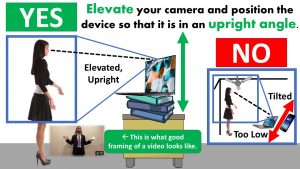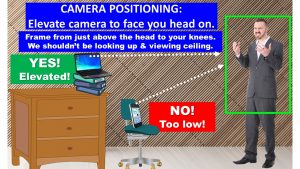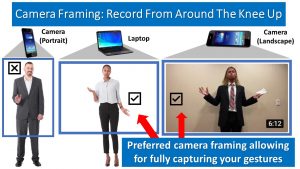Chapter Nineteen – Speaking Online
Speaking online is becoming ever more important to consider as technology advances and opportunities open for various classroom options.
In an online environment, the “sense of urgency” may be gone, but this doesn’t mean that preparation and practice are no longer necessary. The way in which you prepare and your virtual set up is much more important. Below, we discuss how to prepare and how to create an optimal viewing experience.
How do I speak in an Online Class?
Most instructors in an online class require a live audience of a prescribed number of people (4-6 potentially) and/or in a venue like a classroom (not the student’s living room). Always check with your instructor about speech requirements. If you are delivering a speech online, keep these guidelines in mind:
- Film your whole body—not just your head and shoulders.
- Do tech walk-throughs and make sure your camera is working well and picking up your voice.
- Make sure you can get the recording to your instructor. You probably will not be able to just send it through email because the file will be too big. You will have to post it to the cloud or to the learning management system in some manner. Many instructors require posting the video as [unlisted] YouTube file.
- Wear appropriate clothing. Not being in class may tempt you to wear something too informal. This might be an opportunity to go a step beyond in your clothing. Make sure, also, that it looks good on camera in terms of color and lighting in your setting. Some patterns do not look good on camera.
- Along that line, since you probably won’t have professional lighting, get the room as bright as you possibly can, but do not point the camera in the direction of a bright light. The light should be coming from behind the camera.
See the images below for examples of how to frame yourself and how to set up your technology, whether a smart phone or computer device.



How do I Prepare for Online Speaking?

First, recognize that this is a different type of venue. You have two main tools: your voice and your visuals (slides).
If monotone and monorate speaking is horrible for face-to-face speaking, it is truly the “Kiss of Death” for web speaking. The key word is “energy”— an energetic voice has variety and interest to it. Since we tend to have a lower energy level when we sit, some experts suggest that web conference speakers stand to approximate the real speaking experience. This suggestion makes sense. As we have mentioned repeatedly through this book, preparing means practicing your speech orally and physically, many times. Audio-recording yourself during your practice on your smartphone or other device is a good first step, followed by critically and honestly thinking about whether your voice if listless, flat, low-energy, and likely to induce snoozing.
Second, your visuals. Most of us are tempted to put far too much text and too many graphics on the slides, and since the slides are the primary thing the audience will see (rather than your full body), the temptation is even stronger. As one expert on web speaking suggested, if your presentation in the workforce is likely to be graph, data, and information heavy because it’s all information the audience must know, send the information in a report ahead of time. We’ve mentioned information overload before – speeches are not for dumping a great deal of information on audiences.
Therefore, keep your visuals simple. They do not have to have lots of clip art and photographs to keep attention. One rule business speakers like to use is the “10-20-30: rule: No more than 10 slides, no more than 20 words on the slides, and no font smaller than 30 point.” Using 30 point font will definitely minimize the amount of text. Inserting short videos and planning interactivity (such as polls, which the software supports) are also helpful. Refer to Chapter 14 on Presentation Aids for further guidance on visuals.
Also in the realm of preparation, avoid two other problems that are common in webinars. Since some of your presentation might be visible, be sure your background is “right.” Many people perform webinars in their offices, and let’s be honest, some offices provide backgrounds that are less than optimal. They are either messy and disorganized or have distracting decorations. In other cases, you could be sitting in a neutral place with a blank wall behind you, but that setting can have its own issues. Use contrasting colors – if you’re wearing white, don’t stand in front of a white background; you’ll disappear.
It goes without saying that the web speaker must be master of the technology, not be mastered by it. Technology messes up. That is a fact of life. Even if your internet connection is strong, the speaker must know what buttons to push on the software. For this reason, it might be a good idea to have an “assistant” who handles the technology and makes sure it works so that you can focus on the communication.
Experts give a few other preparation tips:
- Make sure you will not be interrupted during the web conference. This can be extremely embarrassing as well as ineffective. You have probably seen the priceless video from the BBC of an interview with an expert on Korea. His children photobomb the interview and then the mother tries to clean up the damage. It is hilarious, but the same situation won’t be for you. Lock the door, put a big sign on the door not to be disturbed, and silence phones.
- Have notes and anything else you need within immediate reach.
- If you can be seen, be seen—use the technology to your advantage so that you are not an entirely disembodied voice talking over slides.
Finally, in preparing, think humor. Humor is a great attention – cartoons, short videos, funny anecdotes, and visual humor can help you work against the audience’s temptations to multitask or daydream in a webinar. There is a limit, and it should be tasteful and relevant, but humor might be one of your best allies. Plus, it might increase your own energy level and fun with the webinar.
What do I do During the Web Speech?
One of the most important things you can do is start on time. This might seem obvious, but if you have ever been in an online meeting or webinar, it’s harder said than done–mainly because participants log on at the start of the meeting rather than early and it takes a while for the technology to kick in. Therefore, one suggestion is to have a “soft” introduction for the punctual and a “hard” opening for the late-comers. The soft intro could be the fun, attention-getting one (video, interactivity) and the hard one the “this is why the topic matters let’s get down to business” opening.
It goes without saying that you as the speaker should be online well before the beginning of the meeting, and ready to go technology- and presentation-wise.
Web speaking is often scheduled for a longer period of time than a face to-face speech, which does not add to attention level of the audience. For this reason, your presentation should include time for questions and input from the audience. However, this should be planned at intervals, perhaps between main sections of the speech, so that the speaker isn’t interrupting at inconvenient times.
Going deeper, perhaps we should ask the fundamental question of purpose. What is your intent in this webinar speech? To educate? To persuade/ sell? To contribute to or facilitate a decision? Something else? Everything else you do comes from that intent or purpose, just like your face-to-face speech comes from the specific purpose speech. What do you really want to accomplish from this meeting?
The other fundamental question is about your audience. Who are they? Where are they? In fact, in some cases the audience is in a different time zone! And that really matters in how a listener responds.
Other experts suggest the following:
- Along with standing up for your presentation, smile. People can hear a smile even when they don’t see you.
- Your anxiety does not go away just because you cannot see everyone in your “web audience.” Also, you might not have ever met the people to whom you are speaking. Be aware of the likelihood of anxiety— it might not hit until you are “on air.” As Ron Ashkenas says, “Anxiety in speaking is like static on the radio.”
- In your use of periodic questions, be specific. The typical “Any questions?-pause- let’s go on” is really pretty ineffective. First, it’s not directed or specific, and second, people need time to formulate their questions and articulate them. Even saying, “What questions do you have?” is better, but even better is to ask specific questions about what you’ve been addressing. Many times you can forecast possible questions, and use those.
- The issue of a question-and-answer period brings up a logistical question. Some participants will question orally through the webcam set-up. Others, with limited technology, will use the chat feature. It takes time to type in the chat feature. Be prepared for pauses.
- Remember the power of transitions. Many people think that slides don’t need transitions because, well, they change, isn’t that enough? No, it’s not. The speaker needs to tie the messages of the slides together.
- Verbal pauses can be helpful. Since one of the things that put audiences to sleep is continual, non-stop flow of words, a pause can get attention.
- Look at the camera, not the screen. You will appear more professional in those cases where the audience can see you.
Ending
As mentioned before, web conferences and webinars can go long—don’t let it. End on time. Allow participants to email you questions if needed, but don’t take advantage of people’s time by entertaining questions longer than the scheduled time. Software allows for recording and archiving, so the audience should know how to access the recording.
- Have only the person speaking appear on the screen with the rest of the team members hidden. This keeps the audience from being distracted by the movement of the other team members but we also lose seeing how interested the other team members are in the speaker.
- Have all team members showing on the screen at once. We can still see the person who is speaking. If this is the option you choose be sure all team members stay attentive to the speaker and do not try to multitask. Keep as still as possible because any movement will draw the audience’s attention.
Here are a two more important tips to make your virtual speech effective.
- There is a lag time on many computers with the sound. This makes it even more important to speak slowly and enunciate your words.
- Be sure and introduce the next person who speaks after you. For example: “I’ve just finished talking to you about the benefits of the on campus messages, now Derek is going to share with you how to sign up for them and where they are located.” Introducing the next person on your team makes for smooth transitions and makes your team look cohesive and organized.
What are the etiquette guidelines for a virtual audience?
When listening to a speaker or instructor in an online environment, you as a listener may have several options as to how visible you are.
- Your name is visible.
- An image of your choice is visible. For example: a flower, symbol, avatar.
- A photo of yourself is visible.
- A live image of yourself is visible.
If we are working from home, it is tempting to stay in our pajamas and be as invisible as possible in the online class or meeting encounters. We can eat, drink, stretch out, multitask or dare I say sleep? Neither the speaker nor the rest of the participants know or is bothered by our behavior. Or are they?!
Just like face-to-face encounters, there is etiquette for online encounters. Keep these guidelines in mind:
- Live image. Turn your live image screen/camera mode ON. Participants and the speaker need to see your face and your reactions to the information being shared. It builds trust. It may also be assumed if we can’t see your face you have snuck out of the meeting. This is disrespectful.
- Mute button. Turn your mute button on unless you have been signaled by the speaker to share a comment. As soon as you have shared be sure and turn your mute button back on. If your mute button is off, even if you are quiet, the sounds in the room around you, a dog, creaky pipes, cars passing the building, will add to the noise of the meeting. Sometimes the speaker or host of the meeting will turn all mute buttons on to manage the noise in the meeting.
- Raised hand. Most online platforms have a button you can select that shows you are raising your hand to ask a question or make a comment. This acts just like when you raise your hand when you are face-to-face and should be used when you want to participate in the conversation. After you have been called upon by the host (either your instructor or speaker) be sure and “un-raise” your hand so the hand icon is not left up on your image.
- Language. Just like in face-to-face conversations, pay attention to your language. Refrain from using disparaging words, discriminatory or foul language either verbally or in the chat option. It is ok to critique ideas or behavior but not people. “I don’t think that idea will work within our budget.” (Ok. A criticism of the idea.) “What stupid person thought of that idea!” (Not ok. A criticism of the person.)
- Enunciate. When you speak, remember there is a lag time in online communication. Speak a little slower than you are used to and enunciate well.
- Chat functions. Oftentimes there is a “chat” function where comments can also be posted as the meeting progresses. This is for comments for the whole group and not to be misused to have private conversations with someone else in the meeting instead of paying attention to the speaker.
- Leave meeting. If for any reason you must leave the meeting before it is over, a message in the chat saying so and why is the polite thing to do. “I need to take a quick restroom break. I’ll be back in 2 minutes.” “I need to leave for the manager’s meeting. Thank you for all the good ideas.” If you can come back, indicate in the chat that you have returned. This lets the speaker know where you are and when you have returned so they can expect your participation again. “This is Steve. I’m back.”
- Reduce multitasking. This last one is the most difficult of all but will pay big dividends. It may be tempting to answer an email, respond to a text message, order something online while you are in an online meeting, however, instead you should:
- participate,
- take notes,
- ask questions,
- stay an attentive listener.
This is good online audience etiquette and will enable you to get more out of each meeting!
Links that might help with this topic:
- 10 tips for giving great online presentations
- How to give a killer online presentation
- Great online presentation
- Five guidelines for effective online presentations
- How to bypass the 5 worst mistakes in online presentations
- 10 tips effective live online presentations
- 10 tips giving effective virtual presentations
- Presenting the perfect online presentation
- Selective attention test
References
- Barton, K., Tucker, B.G. (2016). Exploring Public Speaking 4th Edition. University System of Georgia. https://oer.galileo.usg.edu/communication-textbooks/1/. CC BY-NC-SA 4.0.
- Unknown. Computer apple office social media flowers [Image]. Max Pixel. https://www.maxpixel.net/Computer-Apple-Office-Social-Media-Flowers-605503

